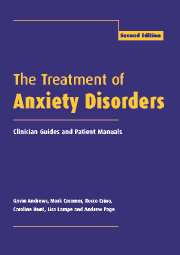Book contents
- Frontmatter
- Contents
- List of authors
- Preface to the second edition
- Abbreviations
- 1 Read me
- 2 General issues in anxiety disorders
- 3 General issues in treatment: Clinician Guide
- 4 Panic disorder and agoraphobia: Syndrome
- 5 Panic disorder and agoraphobia: Treatment
- 6 Panic disorder and agoraphobia: Clinician Guide
- 7 Panic disorder and agoraphobia: Patient Treatment Manual
- 8 Social phobia: Syndrome
- 9 Social phobia: Treatment
- 10 Social phobia: Clinician Guide
- 11 Social phobia: Patient Treatment Manual
- 12 Specific phobias: Syndrome
- 13 Specific phobias: Treatment
- 14 Specific phobias: Clinician Guide
- 15 Specific phobias: Patient Treatment Manual
- 16 Obsessive-compulsive disorder: Syndrome
- 17 Obsessive-compulsive disorder: Treatment
- 18 Obsessive-compulsive disorder: Clinician Guide
- 19 Obsessive-compulsive disorder: Patient Treatment Manual
- 20 Generalized anxiety disorder: Syndrome
- 21 Generalized anxiety disorder: Treatment
- 22 Generalized anxiety disorder: Clinician Guide
- 23 Generalized anxiety disorder: Patient Treatment Manual
- 24 Posttraumatic stress disorder: Syndrome
- 25 Posttraumatic stress disorder: Treatment
- 26 Posttraumatic stress disorder: Clinician Guide
- 27 Posttraumatic stress disorder: Patient Treatment Manual
- 28 Conclusions
- References
- Index
10 - Social phobia: Clinician Guide
Published online by Cambridge University Press: 05 August 2016
- Frontmatter
- Contents
- List of authors
- Preface to the second edition
- Abbreviations
- 1 Read me
- 2 General issues in anxiety disorders
- 3 General issues in treatment: Clinician Guide
- 4 Panic disorder and agoraphobia: Syndrome
- 5 Panic disorder and agoraphobia: Treatment
- 6 Panic disorder and agoraphobia: Clinician Guide
- 7 Panic disorder and agoraphobia: Patient Treatment Manual
- 8 Social phobia: Syndrome
- 9 Social phobia: Treatment
- 10 Social phobia: Clinician Guide
- 11 Social phobia: Patient Treatment Manual
- 12 Specific phobias: Syndrome
- 13 Specific phobias: Treatment
- 14 Specific phobias: Clinician Guide
- 15 Specific phobias: Patient Treatment Manual
- 16 Obsessive-compulsive disorder: Syndrome
- 17 Obsessive-compulsive disorder: Treatment
- 18 Obsessive-compulsive disorder: Clinician Guide
- 19 Obsessive-compulsive disorder: Patient Treatment Manual
- 20 Generalized anxiety disorder: Syndrome
- 21 Generalized anxiety disorder: Treatment
- 22 Generalized anxiety disorder: Clinician Guide
- 23 Generalized anxiety disorder: Patient Treatment Manual
- 24 Posttraumatic stress disorder: Syndrome
- 25 Posttraumatic stress disorder: Treatment
- 26 Posttraumatic stress disorder: Clinician Guide
- 27 Posttraumatic stress disorder: Patient Treatment Manual
- 28 Conclusions
- References
- Index
Summary
Chapter 11 (Social phobia: Patient Treatment Manual) contains the information given to patients in our cognitive behavioral treatment program for social phobia. This chapter discusses the issues of relevance to treatment for the therapist: assessing patients for treatment, the treatment process, and solving problems and difficulties that may be encountered.
fiorking with individuals with social phobia is challenging but rewarding. The treatment program makes significant demands on the patient. Confronting feared situations will generate high levels of anxiety, and doing so consistently is exhausting. To support the person with social phobia in this task requires genuineness, respect, and empathic firmness. Appropriate empathy is assisted by a thorough familiarity with the physiological, cognitive, and behavioral experience of social phobia. Reading case examples can be helpful, but the best learning experience is talking to individuals with a personal experience of social phobia.
Assessment
Diagnosis
This aspect has been covered in detail in Chapter 9. Correct diagnosis is essential. The core cognitions of social phobia differ from those of the other anxiety disorders: the cognitive component of treatment must be directed at the core cognitive distortions of social phobia to be maximally effective.
The presence or absence of comorbid conditions will influence treatment priorities, choice of treatment format and response to treatment.
Comorbid anxiety disorders
Many patients presenting for treatment will meet criteria for more than one anxiety disorder, since such comorbidity is common in the community (Turner et al., 1991;Schneier et al., 1992;Magee et al., 1996;Offord et al., 1996). Simple phobia appears to be the anxiety disorder consistently reported as having the highest rate of comorbidity, with panic disorder, agoraphobia and GAD also frequently reported. Conversely, social anxiety and concerns about negative evaluation occur in other anxiety disorders (Rapee et al., 1988). fihen more than one anxiety disorder is present, the underlying concerns that maintain the anxiety may cover several diVerent cognitive themes. In individual treatment, a comprehensive approach may be planned to cover all areas of concern. Group cognitive behavior therapy (CBT) may be available oVering either general anxiety-management strategies or targeting a specific anxiety disorder.
- Type
- Chapter
- Information
- The Treatment of Anxiety DisordersClinician Guides and Patient Manuals, pp. 177 - 196Publisher: Cambridge University PressPrint publication year: 2002



